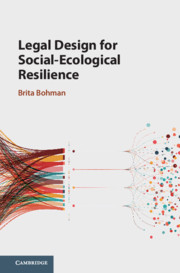Book contents
- Legal Design for Social-Ecological Resilience
- Legal Design for Social-Ecological Resilience
- Copyright page
- Contents
- Preface and Acknowledgments
- Table of Treaties and International Instruments
- Table of EU Law
- Table of Cases
- Abbreviations
- 1 Introduction
- 2 Environmental Law
- 3 Law and Governance
- 4 Defining Features for Resilience Governance
- 5 Adaptivity, Flexibility and Transformability
- 6 Multidimensional and Polycentric Structures
- 7 Stakeholders and Structures for Participation
- 8 Operationalization, Monitoring, Compliance and Trust Building
- 9 Conclusions – Effective Legal Design for Resilience Governance
- References
- Index
2 - Environmental Law
Published online by Cambridge University Press: 10 March 2021
- Legal Design for Social-Ecological Resilience
- Legal Design for Social-Ecological Resilience
- Copyright page
- Contents
- Preface and Acknowledgments
- Table of Treaties and International Instruments
- Table of EU Law
- Table of Cases
- Abbreviations
- 1 Introduction
- 2 Environmental Law
- 3 Law and Governance
- 4 Defining Features for Resilience Governance
- 5 Adaptivity, Flexibility and Transformability
- 6 Multidimensional and Polycentric Structures
- 7 Stakeholders and Structures for Participation
- 8 Operationalization, Monitoring, Compliance and Trust Building
- 9 Conclusions – Effective Legal Design for Resilience Governance
- References
- Index
Summary
The basic scope and characteristics of environmental law is a foundation for this book. Environmental law can take different forms and be seen as an area of law that touches upon many other fields of law with the primary aim of protecting the environment, animals, and human health. Over time environmental law have developed its own legal techniques, norms, approaches, and principles to match the dynamic and holistic perspectives of the ecosystems. The purpose of the book is to identify how law can be designed to match and contribute to social-ecological resilience. The aim is to present a new framework for creating and assessing environmental law in relation to resilience theories; however, the components will be based in current environmental laws (i.e., the specific characteristics of environmental law). This chapter aims to explain some of the fundaments of environmental law and review thecharacteristics that will form important components.
Keywords
- Type
- Chapter
- Information
- Legal Design for Social-Ecological Resilience , pp. 16 - 47Publisher: Cambridge University PressPrint publication year: 2021
- 1
- Cited by

